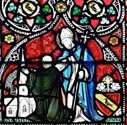 Cropwell Butler Cropwell Butler
St Peter
History
The old chapel in Cropwell Butler, known as St Nicholas’ Church, had disappeared by the mid-17th century. By this date Tythby with Cropwell Butler formed a single parish.
In 1851 this parish comprised an area of 3,610 acres. Despite having its own church, the township of Tythby was substantially smaller than that of Cropwell Butler, with a total population of 116 compared to a total population of 695 in Cropwell Butler.
The parish was endowed with land worth £73, tithes valued at £10 and another permanent endowment of £7 15s, in addition to fees worth £3 and Easter offerings of £1.
In 1845 a small church was erected in Cropwell Butler to serve as a chapel-of-ease. The builder was George Parr, and the building cost £400. It was square-shaped and made of brick. It consisted of a nave and north aisle, with a porch and vestry at the west of the nave.
The aisle was divided from the nave by three pointed stone arches supported by oval pillars.
There were two windows in the north and south walls, and another at the west end of the aisle. George Parr provided a small organ for the building at a cost of 70 guineas. However, this new chapel served a parochial function for only 34 years before it closed in 1879. The precise reason for closure remains uncertain, although, somewhat conspiratorially, the Southwell Diocesan Magazine noted in 1897 that the chapel had been closed ‘for reasons into which there is no reason to inquire’. In this latter year, the chapel was purchased by the parishioners for £200 and subsequently reopened as St Peter’s Mission Church.
When the chapel was purchased by the parishioners in 1897 the building had suffered dilapidation. John Marriot of West Lea organised a sale of work to start an embryonic restoration fund, and succeeded in raising around £96.
Sufficient money was subsequently raised from the bishop of Southwell and from residents of the surrounding neighbourhood for the restoration to take place.
Gilbert Doughty of Nottingham prepared the necessary plans and the contract was subsequently granted to W Whitworth of Tythby and to J Allen of Cropwell Butler.
Restoration works began in August 1897 and, according to the Southwell Diocesan Magazine, succeeded in transforming the ‘somewhat cheerless’ interior of the building into a ‘bright and comfortable’ space. The walls were thoroughly renovated, and a handsome altar and reredos were erected. A new font was provided whilst a pulpit and lectern were installed that had previously belonged to Screveton church.
Although some of the existing furniture was retained, most of the ‘old-fashioned’ seats were replaced by chairs providing seating accommodation for about 120 persons.
A porch and vestry were constructed as part of the restoration (the font was placed between the doors opening into the porch and vestry) and a new floor was laid.
Finally, the chapel was also furnished with a small, ‘sweet-toned’ organ of one manual. Including the purchase of the building, the total cost reached somewhere between £500 and £600, upwards of £500 of which was subscribed. The reopening service was held on 10 November 1897, and was apparently marked by ‘much heartiness, and the foregathering of many friends from the neighbouring villages testified alike to the interest which the event had aroused, and to the appreciation… of the devoted efforts of the Rev F C Cursham’ in effecting the restoration.
The announcement that the bishop of Southwell had consented to perform the ceremony attracted a crowded congregation and Lord and Lady Newark were in attendance.
The clergy and choir met at the vicarage and marched in procession the short distance to the chapel. The first part of the service was undertaken by the Rev G W Oxenham, and was subsequently continued by the Rev P H Droosten (Rector of Bingham) and the Vicar. The Bishop of Southwell read the prayers and dedication and preached from John 1:46. The offertory, which was in aid of the purchase and restoration funds, amounted to £80 8s. 5 ½d. A second service was held in the evening, with the chapel filled to capacity. The sermon was this time preached by the archdeacon of Nottingham, and a collection of £9 14s. 5½d. was taken. At both services Mr H Simons of Screveton played the organ.
In 1905, the cemetery was consecrated, and two years later Godfrey wrote of the church that ‘the fittings are pleasing in character, and accord in every detail with those of an ordinary parish church’.
The chapel-of-ease was closed in 1976 when services were moved to the Methodist chapel.
| 
